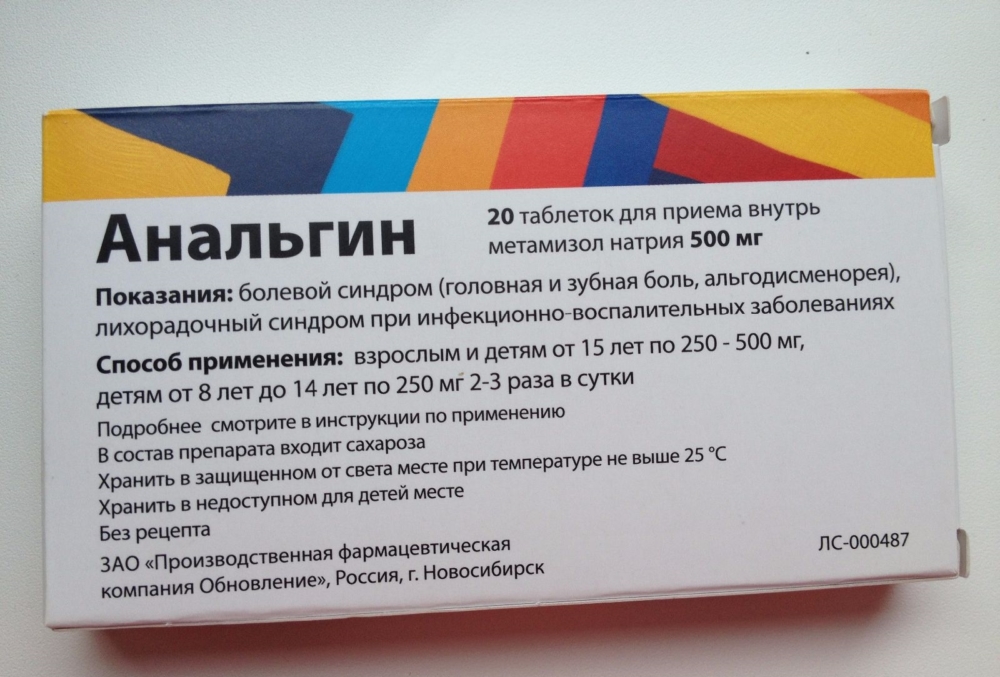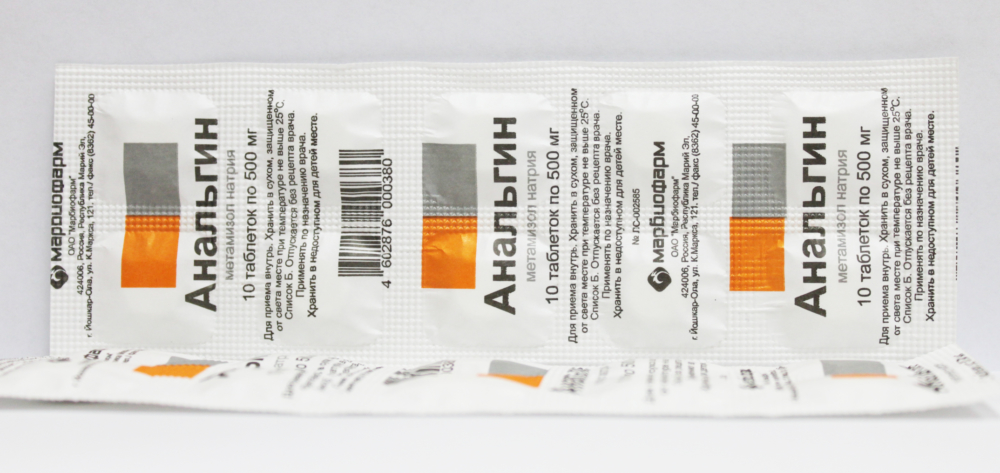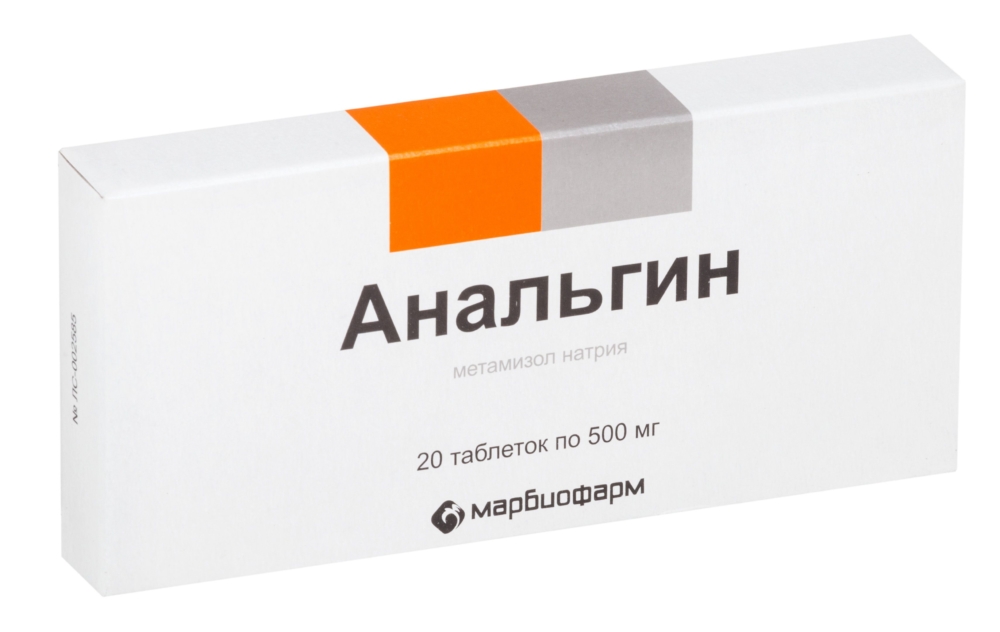In some cases, to relieve the condition, it is possible to prescribe analgin to children. But the drug has age restrictions, and you need to carefully select the dosage. With proper use, the medicine will quickly help get rid of unpleasant symptoms and return the child to normal health.
Material Content:
Composition of the drug
As an active ingredient, Analgin tablets contain 500 mg of metamizole sodium. Sucrose, talc, potato starch and calcium stearate are used as additives to maintain a solid dosage form. Packing is made in plastic or paper blisters of 10 pcs., Which are dispensed in 1, 2, 3 or 5 in cardboard packages. The drug tastes bitter, so children may refuse to take it.
The medicine is also available in the form of a solution for injection. The concentration of the active component in it is 500 mg per 1 ml. The liquid form of the analgesic is provided by specially purified water. The volume of the drug in the ampoule can be 1 or 2 ml, and 10 pieces are in the package.
There are also Analgin candles. 1 suppository contains 100 or 250 mg of active substance. Solid fat is added to provide the desired dosage form. In 1 box there are 10 of them.
Analgin is used as an anesthetic. Its active substance also has small anti-inflammatory and antipyretic properties. The effect is noted after 20-40 minutes. after taking the medicine. The maximum effect occurs after 2 hours.
Why is Analgin prescribed for children
Most often, children are prescribed Analgin for fever. But there are other indications for using this tool:
- muscle pain
- migraine in adolescence;
- inflammation of the nerve or pain along its course;
- colic of renal origin;
- toothache;
- condition after surgery;
- pain during menstruation in girls during puberty;
- biliary dyskinesia;
- headache.
The drug is prescribed for children only with severe pain. The optimal dosage is selected by the attending physician. Self-use of Analgin can lead to the development of side effects.
At what age can a child be given
Medication may be prescribed from birth. The main thing is to choose the right dosage and form of the drug. Up to 5 years, children should use Analgin only under the supervision of specialists. And up to 1 year it is prescribed exclusively in the form of intramuscular injections. Older than this age, intravenous administration and suppositories are allowed. From 10 years, tablets can be prescribed.
Instructions for use, dosage
The medicine in tablet form must be taken orally. The dosage of Analginum for children is calculated based on weight: 1 kg of weight requires from 5 to 10 mg per day, depending on the condition. The tablet should be crushed before use. The course of treatment should not exceed 3 days.
For adults, the optimal dosage is 1 tablet 2-3 times a day. It is better to drink the drug after eating and at the same time with a glass of water to avoid negative effects on the digestive tract. For 1 time it is allowed to use no more than 2 pcs., And per day their quantity should not exceed 6. The optimal course is 3 days when used as an antipyretic and 5 days as an analgesic. If the patient is forced to take the medicine for more than a week, it is necessary to monitor the condition of his liver and the concentration of blood cells.
The dosage should be adapted for each patient. If the pain is not too pronounced, you can prescribe 0.5 tablets to an adult. In the absence of a therapeutic effect, it is gradually increased.
In liquid form, adults from 53 kg are injected with 0.5-1 g of the drug, which corresponds to 1-2 ml. The maximum volume of the drug for 1 time should not exceed 5 ml, and 10 ml per day. For children from 3 months to 1 year, a dosage of 0.1 g is used, and older this volume is multiplied by the number of years lived. The solution before the fence in the syringe and the introduction is heated to body temperature.
You can dilute the drug with Ringer's solution, 5% glucose or 0.9% sodium chloride. Use the mixture immediately, as it is unstable. To mix in one bottle for intravenous infusion or a syringe with other medicines Analgin is not recommended because of possible interaction.
Drug interaction
The use of Analgin as part of complex therapy can lead to unpleasant symptoms due to drug interactions. Their severity and nature depends on the type of drugs:
- the severity of the effect of penicillins, hypoglycemic agents, radiopaque drugs, anticoagulants, colloidal blood substitutes, glucocorticosteroids and indomethacin increases;
- toxic load on the liver increases with the simultaneous use of several non-narcotic type analgesics, allopurinol, antidepressants of the tricyclic structure and combined oral contraceptives;
- anxiolytics and sedatives make the analgesic effect more powerful;
- cyclosporin in this combination becomes less active;
- in combination with phenylbutazone and barbiturates, the effect of Analgin becomes less pronounced;
- the chance of leukopenia when taking sarcolysin and tiamazole increases;
- the severity of the action of Analgin increases with the use of propranolol and codeine.
Analgin is able to interact not only with drugs.When taken simultaneously with alcohol-containing drinks, it increases their effects several times. This can lead to poisoning or damage to the liver.
Contraindications, side effects and overdose
The medicine acts systemically, therefore, has contraindications for use. These include:
- inadequate kidney and liver function;
- hyperreactivity in tribuson and butadione;
- breastfeeding time;
- asthma due to NSAIDs or bronchial in nature;
- early and late gestation;
- pathology of the blood system;
- bronchospasm and diseases in which it can occur;
- hemolytic anemia of a hereditary etiology caused by a lack of glucose-6-phosphate dehydrogenase;
- intermittent porphyria in the acute phase;
- disorders in the hematopoietic system (lack of neutrophils and white blood cells, lack of granulocytes);
- low blood pressure.
The use of Analgin for children under 3 years of age is not contraindicated. But this should be done under the supervision of specialists in the hospital. This will help to avoid adverse events.
Side effects of the drug include:
- bronchospasm;
- hypotension;
- rashes;
- anaphylactic reactions;
- angioedema;
- lack of leukocytes and platelets, lack of granulocytes;
- Lyell's syndrome;
- the absence or decrease in the amount of urine, the appearance of protein in it, staining in red;
- inflammation of the interstitium of the kidneys;
- Stevens-Johnson syndrome.
If you use Analgin for more than a week, signs of an overdose may occur. These include:
- lack of granulocytes in the blood;
- bouts of nausea;
- convulsive syndrome;
- decrease in body temperature;
- gagging;
- loss of consciousness;
- respiratory muscle paralysis;
- stomach ache;
- decreased urine output;
- hypotension;
- acute liver and kidney failure;
- increase in heart rate;
- hemorrhages;
- noise in ears;
- rave;
- dyspnea;
- pathological fatigue.
If one of the symptoms appears, you should seek medical help. This may endanger the life and health of the patient. Therefore, during treatment you need to be very attentive to the patient's condition.
Similar in composition
Analgin has several analogues. These include:
- Baralgin;
- Analgin Ultra;
- Optalgin.
The drug Analdim also contains diphenhydramine in the composition, which enhances the action. Benalgin, in addition to the same active ingredient, includes caffeine and thiamine, which help fight the patient’s hypotension and general lethargy. But these drugs have their own side effects and contraindications. Therefore, it is not recommended to replace the original product with them on their own.
Analgin has been used in pediatric practice for a long time and shows good results in case of emergency care. It is used in children from birth under the supervision of specialists. But kids should not prescribe it on their own because of the difficulty in calculating the dosage and possible side effects.
















